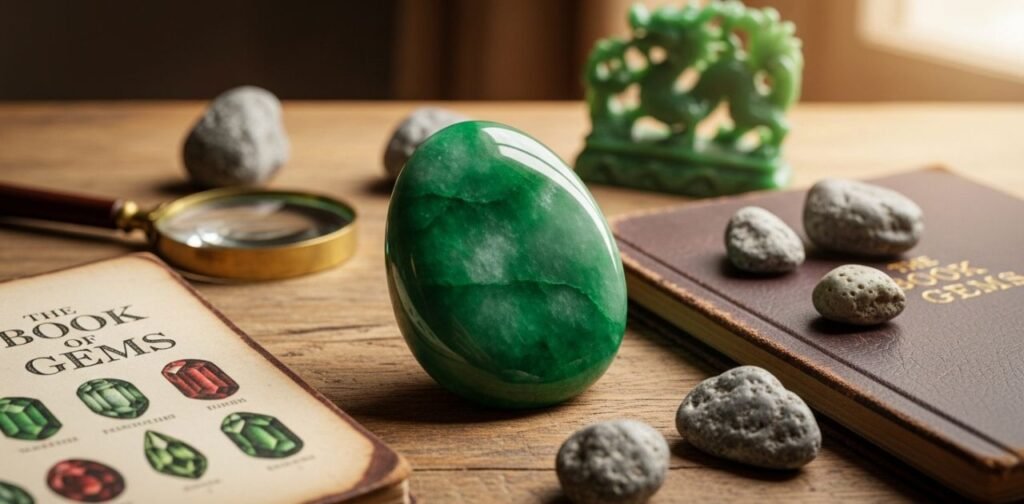For centuries, jade has been revered as one of the most mystical and valuable gemstones. Known in Slovak as “jadeitový kameň”, this stunning crystal is more than just a piece of jewelry—it is a symbol of prosperity, healing, and balance. From ancient Chinese dynasties to modern holistic practices, jade continues to play a powerful role in both cultural traditions and everyday life.
In this detailed guide, we’ll explore the origins, meanings, healing benefits, and practical uses of jade stone, while also uncovering why it remains such a treasured gem around the world.
What is Jade Stone and Where Does it Come From?
Jade is not a single mineral but a collective term used for two distinct stones: jadeite and nephrite. Both are prized for their durability, beauty, and spiritual significance. However, jadeite is considered rarer and more valuable due to its vibrant colors and translucency.
- Jadeite: Found mainly in Myanmar (Burma), Guatemala, and Japan. It comes in a variety of shades, including emerald green, lavender, orange, and even black.
- Nephrite: More common and usually comes in softer green, cream, or gray tones. It is mined in regions like China, Canada, New Zealand, and Russia.
Historically, jade has been discovered in archaeological sites across Asia, Central America, and Europe, where it was used for tools, weapons, ornaments, and spiritual rituals. In China, jade was often referred to as the “Stone of Heaven”—a bridge between humans and the divine.
Today, jade remains a highly sought-after gemstone, valued both for its ornamental beauty and its metaphysical properties.
Symbolism and Spiritual Meaning of Jade Stone
The symbolism of jade runs deep across cultures, making it much more than a decorative crystal. In many traditions, jade is considered a stone of luck, protection, and harmony.
- In Chinese culture, jade is believed to attract prosperity, longevity, and health. Jade amulets were often buried with emperors as symbols of immortality.
- In Mesoamerican civilizations, such as the Mayans and Aztecs, jade was considered more valuable than gold. It represented life, fertility, and spiritual power.
- In modern metaphysics, jade is viewed as a stone of balance and peace. It is thought to align the heart chakra, promoting love, emotional healing, and compassion.
Because of its reputation as a stone of good fortune, many people wear jade bracelets, pendants, or rings as a protective charm. It is also a popular crystal in feng shui practices, believed to bring harmony into homes and workplaces.
Healing and Metaphysical Properties of Jade
Beyond symbolism, jade stone is also highly valued in crystal healing practices. Although scientific evidence is limited, many users believe in its spiritual and emotional benefits.
Some of the most common healing properties attributed to jade include:
- Emotional Balance – Jade is said to calm the mind, reduce stress, and promote inner peace.
- Attracting Prosperity – Often called a “lucky stone,” jade is believed to help manifest wealth and opportunities.
- Physical Healing – In holistic traditions, jade is thought to support the kidneys, heart, and immune system.
- Heart Chakra Activation – Green jade resonates with the heart chakra, fostering love, compassion, and harmony in relationships.
- Protection – Worn as jewelry, jade is seen as a protective amulet that shields the wearer from negative energy.
It is no surprise that jade has found its way into wellness tools such as jade rollers and gua sha stones used in skincare. These tools not only feel cooling on the skin but are also believed to stimulate circulation and encourage relaxation.
Uses of Jade Stone in Modern Life
Jade’s beauty and energy have made it a versatile stone with multiple applications:
- Jewelry – Rings, bracelets, necklaces, and pendants crafted from jade are timeless fashion statements and spiritual talismans.
- Feng Shui – Jade figurines, statues, and carvings are placed in homes or offices to attract abundance and harmony.
- Skincare – Jade rollers and gua sha tools are widely used in beauty routines to reduce puffiness and promote glowing skin.
- Meditation and Healing – Practitioners use jade during meditation sessions for grounding and connecting with higher consciousness.
- Cultural Artifacts – Jade carvings, especially in Asia, hold deep historical and cultural significance.
Its ability to combine practical beauty with spiritual depth makes jade one of the most versatile and enduring gemstones in human history.
How to Identify Real vs Fake Jade
Because jade is so valuable, counterfeit or dyed imitations are common. To ensure authenticity, here are some tips for identifying real jade stone:
- Temperature Test – Real jade feels cool to the touch and takes time to warm up in your hand.
- Scratch Test – Genuine jade is very hard and cannot be easily scratched with a knife.
- Light Test – Hold the stone under light; authentic jade often shows fibrous or granular patterns.
- Price and Source – If the price seems too good to be true, it probably is. High-quality jadeite especially commands premium prices.
- Certification – For valuable pieces, always ask for a gemological certificate.
Being aware of these checks helps you avoid imitations such as dyed quartz, serpentine, or glass that are often sold as jade.
Caring for Your Jade Stone
Jade is a durable stone, but proper care ensures its beauty lasts for generations:
- Cleaning: Use mild soap and water; avoid harsh chemicals.
- Storage: Keep jade jewelry in a soft pouch to prevent scratches.
- Energy Cleansing: Many people cleanse jade spiritually by placing it under moonlight or rinsing it with clean water.
- Avoid Heat: Do not expose jade to extreme heat, as it may damage its surface.
With good care, jade can become a treasured heirloom passed down through families.
Frequently Asked Questions (FAQs)
1. What does jade symbolize?
Jade symbolizes luck, prosperity, balance, and protection. In many cultures, it is considered a sacred stone that brings harmony and longevity.
2. What is the difference between jadeite and nephrite?
Jadeite is rarer, more valuable, and comes in brighter colors, while nephrite is more common and often appears in softer green or gray shades.
3. Can jade be used for healing?
Yes, in holistic practices jade is used for emotional balance, physical healing, and chakra alignment, though scientific evidence is limited.
4. Is jade good for feng shui?
Absolutely. Jade is often placed in homes and offices to attract wealth, harmony, and protective energy.
5. How can I tell if jade is real?
Real jade feels cool, is very hard to scratch, and shows unique fibrous patterns. Certification from a trusted gem lab is the best way to confirm authenticity.
6. Is jade suitable for everyday wear?
Yes, jade is durable and can be worn daily, but it should be cleaned regularly and protected from harsh chemicals.
7. What colors does jade come in?
While green is the most famous, jade can also appear in lavender, white, yellow, orange, and even black.
Conclusion: Why Jade Stone Remains a Timeless Treasure
From ancient civilizations to modern wellness trends, jade stone (jadeitový kameň) has stood the test of time as one of the world’s most treasured gems. Its unique combination of beauty, symbolism, and healing energy makes it far more than just a decorative crystal—it is a stone of prosperity, harmony, and protection.
As the world continues to embrace both spirituality and holistic wellness, jade’s role is only expected to grow. Whether worn as jewelry, displayed as an artifact, or used in meditation and skincare, jade remains a symbol of timeless wisdom and enduring strength.
Owning a piece of jade is not just about style—it is about carrying a piece of ancient energy that has guided civilizations for thousands of years. And in today’s world, that connection to balance and truth feels more valuable than ever.



